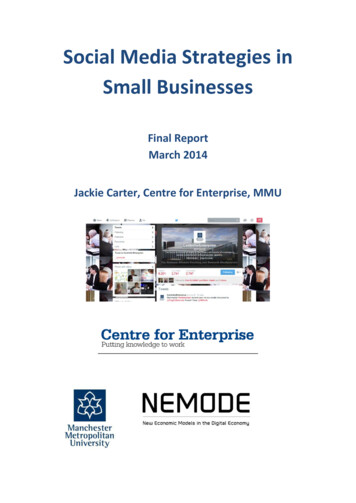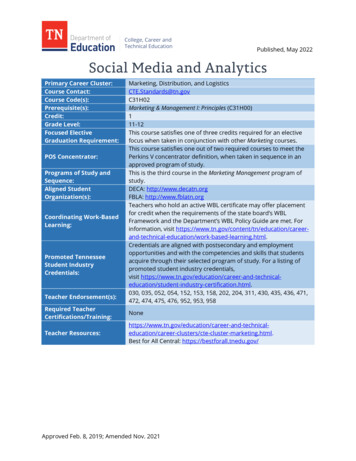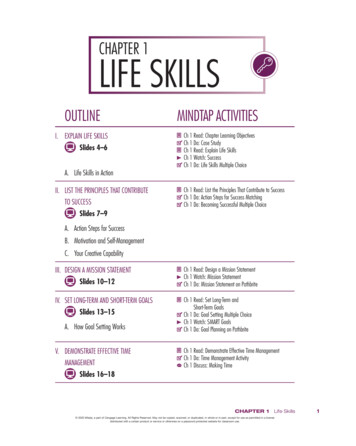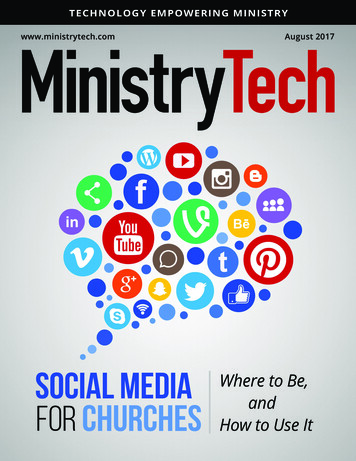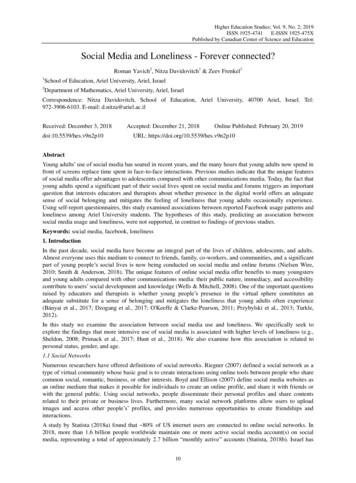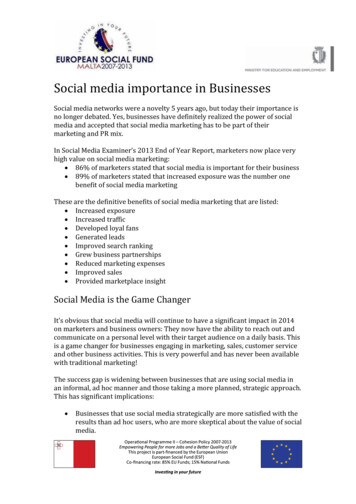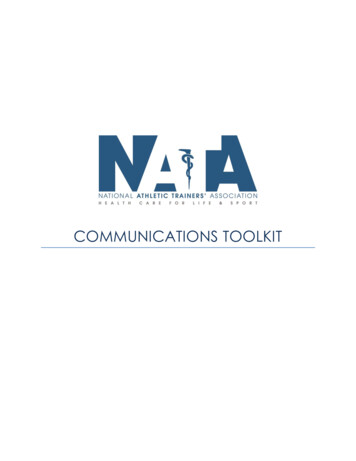Transcription
Follow us on Social /iconcope/https://twitter.com/ICON COPE#ICONHampshire
Babies Cry, You Can CopeThe background to ICONDr Suzanne Smith PhD, MA, BA, RGN, RHV:ICON FounderandChief Programme Advisor
AKA Shaken Baby Syndrome Child Abuse Catastrophic injuries: Brain injuries Bleeding behind the eyes Bony injuries Causal mechanism rarely confirmedAcceleration/deceleration Impact 1 in 14 cases – fatal before hospital discharge Half of severely injured survivors die before aged 21.
2011 20– 24 per 100,000 in first year District General Hospital – paediatrician canexpect to see a case every 1 or 2 years 2.6% of American parents admitted to shaking achild under 2 years; 9% felt like shaking Cases seen by paediatricians – only a proportionof cases of AHT It’s the leading cause of death and long-termdisability for babies who are abused
Survival with significant brain injury or death Emotional cost Inpatient hospitalisation (Paediatric Intensive Care) Long term medical services – PhysiotherapyOccupational TherapySpeech and Language TherapyEducational needs Foster care Family and criminal proceedings Prison/probation Serious Case Review cost (circa 75,000) Loss of societal productivity and occupational revenue.
70%perpetrators are males – fathers/malesurrogates (Kesler et a 2008; Altman et al 2010) Can occur in every socio-economic group Coping with crying: Living on the edge Caregivers lose control and shake – baby stops crying Demonstrable relationship between the normal peakof crying and babies subject to AHT. (Barr et al 2006) Increase in cases in the 1st month of life, a peak at 6weeks during the 2nd month and a decrease duringthe 3rd to 5th months of life
Success depends on controllability Problem solvingwhere the stressor cannot becontrolled can lead to frustration and distress support through the problem rather than solvingthe problem The need for a careful approach towards aresponsive professional intervention that is rootedin evidence is, therefore, crucial
Travel toLearn: Return to Inspire The aim of this Fellowship was to exploreinternational programmes related to theprevention of child maltreatment with a particularfocus on AHT in infants and to gain anunderstanding about the wider context of thedelivery of care and the systems and processes inwhich they are provided and commissioned.
SEEK (Safe Environment for Every Kid)Baltimore, Maryland Shaken Baby Syndrome Prevention ProgrammeHershey, PA Safe Babies New YorkBuffalo, NY Period of Purple CryingVancouver, BC Period of Purple Crying and Child Advocacy CentreHelena, MT Period of Purple Crying and Family Support CentreWichita, KS
A practical evidence-based tool to briefly and systematically screen parents for prevalentpsychosocial problems that are risk factors for child maltreatment, and that generallyjeopardize children's health, development and safety. Parental Depression Parental Substance Abuse Harsh Punishment Major Parental Stress Intimate Partner Violence Food InsecurityThe SEEK PQ is also:Designed to screen for, not diagnose, risk factors for child maltreatment. It is Validated for usein primary care practice and is intended for parents to complete, voluntarily, in advance oftheir child's regular check-up.
SEEK resulted in significantly lower rates of childmaltreatment in all the outcome measures: fewerChild Protective Services reports, fewer instances ofpossible medical neglect documented as treatmentnon-adherence, fewer children with delayedimmunizations, and less harsh punishmentreported by parents. Families with prior childwelfare involvement were not excluded from thestudy sample, blending results for primary,secondary, and tertiary prevention (intervention)samples.
Dose1: hospitals and birthing centres Dose 2: strategic reinforcement of the PURPLEmessage outside of the hospital Dose 3: increase the opportunity for publicawareness of AHT through a ‘positive communitynorms’ campaign on AHT. Video
Hospital Based Prevention Programmes 96217/11476368/2016 3rd Quarter Newsletter/db2cccdb-90ff-45c0-a917-7169cbf9362f Safe Babies New York (same s/2016/06/20160615053919 SafeBabies-NY-Brochure-ENGLISH-FINAL-2016-01.pdf
A co-ordinated, hospital based parent educationprogramme targeting parents of all newborn infantscan significantly reduce the incidence of abusive headtrauma in children less that 36 months.Dias et al (2005) Preventing Abusive Head Trauma Infants and Young Children: a hospital based prevention programPediatrics 115: 470 – 477 16 infants who were born in the 8 year study period weretreated at the children’s hospital for shaking injuriessustained during their 1st year of life. Of those infants 14were born during the 5 year control period and 2 during the3 year post implementation period. The decrease from 2.8injuries/year to 0.7 injuries/year represents a 75%reduction (P 03).Altman et al (2010) Parent Education by Maternity Nurses and Prevention of AHT.
Although the frequency of AHT cases decreased, it is notpossible to be absolutely certain that the educationalprogramme was the cause of the decrease. Uncertaintyabout the cause and effect relationship is an inherentlimitation of before/after study design, but the absence ofchanges over time in 3 nearby states without similarprevention programmes lends support to a cause/effectinterpretation Fathers and male surrogates are nearly 5 times as likely asmothers to shake an infant. From the parents surveyedonly 40.4% of fathers watched the educational video.Finding better ways to reach male caretakers should be apriorityAltman et al (2010) Parent Education by Maternity Nurses and Prevention of AHT.
The primary aim of this study was to determine whetherthere was any change in visits of 0 to 5 month old infants tothe Medical Emergency Room (known as the EmergencyDepartment in the UK). After program implementation, crying cases were reducedby 29.5% (p .001). The most significant reductions werefor crying visits in the first to third months of life. The authors concluded that the findings imply thatimproved parental knowledge of the characteristics ofnormal crying secondary to a public health program mayreduce Medical Emergency Room use for cryingcomplaints in the early months of life.Barr R G, Rajabali F, Aragon M; Colbourne M., Brant R., Education About Crying in Normal Infants Is Associated with a Reduction inPediatric Emergency Room Visits for Crying Complaints J Dev Behav Pediatr 36:252–257, 2015
My WCMT report recommends a multi agency co-ordinatedprogramme that touches on all the different levels ofprevention.Each ‘touch point’ is brief & can combine ‘safe sleep’ whilstreinforcing simple messages: Infant crying is normal Comfort methods will sometimes be able to sooth the babyand the crying will stop. it’s OK to walk away when you have checked your baby issafe and if the crying is getting to you. Never ever shake or hurt a baby.
Charlee’sAngels: funded travel for familiesaffected by AHT to an initial consultation event.Hosted private group on social media forconsultation. Families have all commented on allparts of the process and materials. Dynamic partnership with Kim Jones. Established a national steering group initially inRochdale, now transferred to Hampshire. Engaged with Royal College of Paediatrics andChild Health and The University of Birmingham. Presented ICON at a Winston Churchill MemorialTrust conference in March 18.
Impacton numbers of AHT victims – notcompletely reliable as an indicator ofsuccess. Impact on numbers of parents/carersattending Emergency Departments with‘crying baby’ – and no signs of illness. Qualitative measures – parental reports, dothey remember the message, have theyrecalled it/used the materials when theyneeded to etc. FUNDING.
Pause for thought .
ICON – Hampshire’s ExperienceKim Jones: Designated Nurse forSafeguarding ChildrenWest Hampshire Clinical CommissioningGroup
Development of ICONFollowing a recommendation from Child U’s Serious Case Review for a localpreventative campaign, contact was made with Dr Sue SmithA presentation was made to the Hampshire Safeguarding Children Board’s Learningand Inquiry GroupA proposal and presentation for a campaign was made to the HampshireSafeguarding Children Board’s Board meeting in June 2017, which was fullyendorsedA task and finish group was formed
Hampshire’s task and finish group joined the national steeringgroup hosted by Rochdale Clinical Commissioning Group: Hampshire led on the development of ICON materials andcollaborated with parents via Dr Smith and Mae Hampshire’s group sought feedback from children, youngpeople, parents/carers and professionals on the materialsand the messages Hampshire led on a pilot across children’s services, healthand inclusion to gain feedback from parents/carers andprofessionals about the ICON messages and materials.ICON Journey
ICON Journey – PreventionSpecialist – improvedrecognition andreferralTargeted – Socialworkers/paediatriciansPublic HealthMessage to allparents31
Universal Stages of ildrenincludingFixers FilmGP 6 WeekCheckRed BookPre-birthvisits fromHV/FNPandMidwifeHV contactSupported by ICON training, parent leaflet with script forprofessionals, fridge magnets, posters, films, social media campaignsand DadPad App for parents (targeted at males)
Targeted Stages of PreventionChildren’sServices – FamilySupport (EarlyHelp)ParentingSupportInclusion TeamEarly Yearssettings –nurseries andday-careFamily NursePartnership foryoung parents (incertain areas)
Tertiary Stage of ecutionJudiciaryEducation
Next Steps for ICON?Hampshire are the newly appointed national lead for ICONLaunch and promote ICON amongst professionalsWork with Fixers to develop a film for children and young peopleLaunch to the general public utilising ‘Daisy the Bus’Evaluate and publish evidenceEngage with other areas to nationally grow ICON
Teaching Children and Young People aboutAbusive Head TraumaSteve Morton: Teaching and LearningAdviser for Personal DevelopmentLearning
Should ICON be taught in Schools?Teaching children and young people about Abusive HeadTrauma (AHT) raises issues regarding how this sensitivesubject (and, indeed, the whole concept of abuse) ispackaged and delivered so that pupils have a real depth ofunderstanding and an increased knowledge of thepotential harm caused by AHT.
Good schools will have robust policies and programmes for Personal Development.A reflection and perhaps an extension of a school’s commitment to all aspects ofSafeguarding.Preparing children and young people for all aspects of life through a Personal,Social and Health Education programme (PSHE).Taught overtly and is fundamental to whole school ethos.Teaching about AHT: Thewider context
AHT fits in to the category “teaching sensitive subjects” however that coversvirtually all of the PSHE curriculum.It’s a scary subject, so teacher competence and confidence is of paramountimportance.Must not be taught in isolation from the rest of the curriculum.Teaching about AHT
Not taught in isolation .So, how best to approach this subject?The “Fixers” film as an initial stimulus for discussionTeaching about AHT:Joined up thinking
Any teaching about AHT needs to be given in a clear and relevant context. Thisis important life skills information that can sit in several areas of personaldevelopment learning. These could include:Child care skills (looking after infants, parenting and baby sitting)
Rights Respecting Education (UNICEF articles on the rights of the child)Discussions based around factual and fictional narratives about AHT (in the contextof an English lesson)Role play and drama with a focus on AHT
Engagement with Young People – How do wedeliver the ICON message
Because the vast majority of AHT cases result from an inability to cope with acrying infant, it is important that the Emotional health and Wellbeing conceptis used to underpin deeper understanding (shaking a baby in anger is adangerous and inappropriate response to a stressful situationAlthough young people of school and college age may not consider themselvesready to be taught about any aspect of parenting it’s important that the ICONmessage is given a wider context. Consideration needs to be given alongsidediscussions about healthy and unhealthy relationships including; abusive andcontrolling relationships, anger management, substance misuse, consent, bodyawareness and personal space, how to stay safe etc.The importance ofEmotional Health andWellbeing
The new Department for Education draft statutory guidance for Relationships andSex Education (published July 2018)Consultation period until 7th November 2018An ideal opportunity to discuss issues about abusive behaviours in the wider contextof “teaching about healthy relationships”Opportunity to influencepractice
Primary Prevention StrategyDawn Oliver:Named Midwife Safeguarding ChildrenHampshire Hospitals NHS Foundation TrustJayne Condie:Area Manager Health Visiting TeamSouthern Health NHS Foundation TrustDr Jenny Rattray:Named GP for Child SafeguardingFareham and Gosport and South East Hampshire CCG
Midwifery
HHFT Associate Director of Midwifery and Women’s Health has committed todelivering the ICON message to parents and carers from 28 weeks gestation.Following the success of the pilot the programme of intervention (as per theprevious slide) will be embedded within the service.Maternity staff will be trained to deliver the ICON message to parents and carers. Anational script has been produced for maternity professionals to support thisconversation which reinforces the key points from the ICON materialsGetting the message outthere
Frombooking28-36weeks Referral sent to HV/FNP following booking by Midwife HV's to discuss ICON message at Antenatal contact. For FNP clients discuss ICON message during a Pregnancy visit agenda matched with client. For those not FNP but on Teenage Pregnancy pathway discuss ICON at second antenatal visit Discuss normal crying, baby states and management strategies Check if ICON leaflet and information has been given and any concerns raised. If not , give information and leaflet (refer to ICON training) and include any other adults in the house Document discussion in parent held child health records and electronic records Discuss normal crying, baby states and management strategies Check if ICON leaflet and information has been given and address any concerns raised.New Birth If not , give information and leaflet (refer to ICON training) and include any other adults in the houseContact Document discussion in parent held child health records and electronic records Discuss normal crying and management strategies Re-iterate ICON message and include any other adults in the house.Post natalcontact Document discussion in parent held child health record.Health Visiting
In Hampshire there around 12,000-15,000 babies born each year. Each familywill be offered an antenatal contact with a Health VisitorAll staff will attend training around discussing the ICON message as part of theantenatal contact. This will be alongside Safe sleep and expectations of being aparent as part of the promotional guide.ICON will be embedded within the programme for first time parents groups part of the transition to parenthood high impact areaAudits will take place to ensure message has been heard by familiesGetting the message outthere
All new babies and their mothers have a check up by their GP at 6-8 weeks old.Currently no standardised protocol for the maternal part of this check up.Perinatal mental health affects 1 in 5 women and 1 in 10 men and is underdiagnosedin 50% of cases, according to research.Often new parents are scared to disclose mental health issues and domesticabuse to their GP due to fear their children will be taken away, and will insteadwait to be askedSome GPs lacked time or understanding that the postnatal check was more than justa physical examImproving diagnosis and management of perinatal mental illness is a clinicalpriority for the Royal College of General PracticeGeneral Practice
Holistic template embedded into GP computer system which encompasses: Mental health assessment Domestic abuse screening Social support assessment Postnatal health education (to include ICON advice and safer sleeping advice) Physical health assessmentGPs now receive training in discussing coping with crying and how to use thetemplate in practice as part of their annual safeguarding trainingStandardising care across HampshireLinks within the template to RCGP perinatal mental health toolkit, DadPad andthe ICON website for additional support for GPs and parents/carersTemplate for the 6-8 weekpostnatal appointment
Universal Services pilot feedbackParents33% documentedthat it was OK towalk away if yourbaby is in a safeplaceTake astep backif I feelstressed22% stated thatthe keymessage wasnever shakeyour babyGreatadviceSpeak tosomeone if Iam struggling10% notedthat somebabies crymore thanothers.62% notedthat cryingin babiesis normal /OKFeel moreconfidentI’m doinga good job
Universal Services pilot feedbackProfessionalsHaving the ICONmessage helpedme discuss it in aconcise way thatmum seemed torespond toHelpfulprompts toask thedifficultquestionsIt allowed meto give a reallyclearexplanationVery usefuland clearI reallyliked itI found asking ‘ismotherhoodeverything youthought it wouldbe?’ was a greatway to get mum toopen upI liked being ableto give it topatients todiscuss withother care-giversso I knew themessage would bepassed on
Secondary Prevention StrategyFiona ButtSupervisor Family Nurse PartnershipSouthern Health NHS Foundation TrustFamily Support ServiceHampshire County CouncilMarg DunneInclusion Team LeaderServices for Young ChildrenHampshire County Council
The Family Nurse Partnership is a licensed, intensive nurse-led prevention and Earlyintervention programme for young parents.In Hampshire it is delivered in Gosport and Havant, Basingstoke and Rushmoor.Babies of young parents are particularly vulnerable to abusive head traumabecause of less emotional regulation due to the developing Adolescent brain.Maximum 64 visits beginning in early pregnancy until child is at least 1 year.What is Family NursePartnership?
Introduce ICON as part of pregnancy visits alongside safe sleeping adviceUse of doll to demonstrate effects of shakingReview in initial and subsequent visits after baby’s birthGetting the message out there
Family Support Service –Early HelpHow the ICON message is incorporatedinto Early Help: Secondary level of intervention sosupport is targeted at Level The message is delivered in parentinggroups, aimed at Early Years Parents of young children who areasking for help with crying will beinvited to SOS clinic Build awareness within CS throughmeetings, training opportunities,include ICON in work plans Target families and build awarenessthrough Early Help Hub Multi-agencymeeting Direct 1:1 work with families withyoung children Build awareness with partner agencies– workshops and trainingopportunities
Family Support Service – The ICON pilotWhat we didWhat wefound out Trained staff across 3 districts Incorporated into all parenting groups Direct 1:1 work with parents of babies, young children, expectant parents Information stands at Messy Play and District Day Identified families at Early Help Hub meetings Difficulty in blending the message into a parenting programme Poor retention for parenting groups means some parents miss the ICON message 1:1 sessions could be adapted easily to meet the learning needs of some parents As a talking point, ICON opened conversations and parents passed this onto others Parents love the fridge magnet – it’s a help reminder to take a step backWhat worked Parents engaged with information stands – they came to us to learn moreWhathappens next Choose an appropriate session within parenting programme and focus on Early Years Promote direct work. 1:1 sessions with parents Increase the range of the message to level 4, nurseries, pre-schools, voluntary agencies
Services for Young Children (SfYC)Inclusion TeamWe are a team supporting Early Years children (0 to 4 years) with SpecialEducational Needs in their homes and in their Nurseries, Preschools andchildminder settingsTeam Leaders shared ICON message with individual district Teams to enablethem to cascade the ICON message through their work with parents andpractitioners
How will the Inclusion Team share this message?Ensure our preschools/ nurseries/ childminders prominently display the ICON posterfor all parents to see - Suggestions have been to put a leaflet in their welcome packwhen a child starts their setting, or to hand a leaflet to a pregnant parent.Ensure Inclusion Team/ practitioners make a point of talking to every parent with ayoung baby to see “how they are” and discuss coping with crying/ crying patternsfor support or signpost to appropriate services if required.Ensure that the ICON message is shared widely to parents with leaflets/ fridgemagnets as appropriate.
Secondary Services pilot feedbackICON was sharedwith otheragencies at multiagency tion standworked well whichparents engagedwith1:1 sessionsadapted thesession to meet theneed of the familyChoosing theright sessionfor themessage to bedeliveredParents whoattendedgroup, sharedtheirexperienceswith otherparents
Pause for thought
Promotional FilmsThe ICON MessageICON – You Can CopeSelf Care Tips for New ParentsAvailable for you to download onthe AHT Online Toolkit!
Fridge Magnet/ leaflet
Poster
kits/abusive-head-trauma
Follow us on Social /iconcope/https://twitter.com/ICON COPE#ICONHampshire
Barr R G, Rajabali F, Aragon M; Colbourne M., Brant R., Education About Crying in Normal Infants Is Associated with a Reduction in Pediatric Emergency Room Visits for Crying Complaints J Dev Behav Pediatr 36:252-257, 2015 . Engaged with Royal College of Paediatrics and



